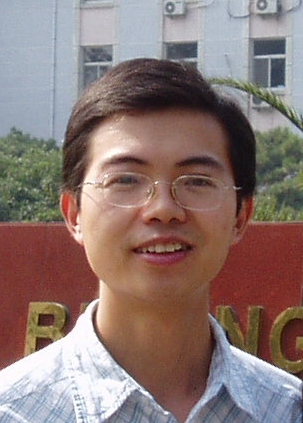Plenary and Keynote Talks
Plenary Speaker: Takahide Yoshiike

Title: Challenges toward human co-existing humanoids
Abstract:
Honda has researched on humanoid robots from 1986 aiming at robots which can co-exist with human. In this talk, overview of humanoid robot development in Honda, including ASIMO, is presented. One of the Honda’s contributions to humanoids research is bipedal locomotion. Therefore,some technical approaches are explained and also some recent achievements are shown, focusing on locomotion itself, transition between different locomotion types, and locomotion with absorbing impact at an unexpected collision.
Bio:
Mr. Takahide Yoshiike finished his master at University of Tokyo (Mechano-infomatics) in 1998. He started to work at Honda R&D Co., Ltd. from 1998 and has worked on control of biped robot ASIMO and E2-DR. Now he is principal engineer in Honda Research Institute JapanCo., Ltd. His interest is motion control of humanoid robot including bipedal locomotion.
Plenary Speaker: Sven Behnke

Title:Perception and Planning for Autonomous Humanoid Robots in Complex Environments
Abstract:
Humanoid robots need to perceive their environment to act in a goal-directed way. This includes simultaneous localization and mapping, traversability analysis and semantic categorization of surfaces, object detection and pose estimation, as well as the perception of persons. In the talk, I will report on efficient methods that we developed for environment perception, based on local multiresolution surfel representations,deep learning, and object-centered representations. The resulting models formthe basis for locomotion and manipulation planning, for which efficient methodsbased on local multiresolution, abstraction, and adaptive motion primitives have been developed. Our team integrated perception and planning for autonomous control of humanoid robots and demonstrated their abilities in complex environments, including soccer, domestic service, space exploration, and disaster-response.
Bio:
Prof. Dr. Sven Behnke heads the AutonomousIntelligent Systems group at University of Bonn, Germany, since 2008. He received a MS degree(Dipl.-Inform.) in 1997 from Martin-Luther-Universität Halle-Wittenberg and a PhD in Computer Science (Dr. rer. nat.) in 2002 from Freie Universität Berlin.He spent the year 2003 as postdoctoral researcher at the International Computer Science Institute in Berkeley, CA. From 2004 to 2008, Prof. Behnke headed the Humanoid Robots Group at Albert-Ludwigs-Universität Freiburg. His research interests include cognitive robotics, computer vision, and machine learning. His robot competition team NimbRo was highly successful at multiple international challenges, including RoboCup Humanoid League soccer, RoboCup@Home, DARPA Robotics Challenge, European Robotics Challenges, and DLR SpaceBot Cup.
Keynote Speaker: Abderrahmane Kheddar

Title:Recent advances in humanoid control using quadratic programming
Abstract:
Humanoid robots are gaining more maturity in terms of hardware and embedded software. Each year we witness the improvement of an existing series and the revelation of new platforms. This talk focuses on task-space multi-objective controllers that write as quadratic programs (QP) to handle multi-robot systems as a single centralized control. By doing this, the tasks specification simplifies substantially. At the heart of the interactions between the systems are the contact forces and visual servoing: we provide methodologies to achieve reliable force and vision tracking with our multi-robot QP controller. The approach is assessed with a large panel of experiments on real complex robotic platforms.
Bio:
Professor Abderrahmane Kheddar received the BSCS from the Institut National d’Informatique, Algiers, MSc and PhD in robotics, both from the University of Paris 6. He is presently at CNRS and the Codirector of the CNRS-AIST Joint Robotic Laboratory, Tsukuba, Japan. He is also leading the Interactive Digital Humans team at CNRS-University of Montpellier LIRMM, France. His research interests include haptics, humanoids and thought-based control using brain machine interfaces. He is a founding member of the IEEE/RAS chapter on haptics, the cochair and founding member of the IEEE/RAS Technical committee on model-based optimization, he is a member of the steering committee of the IEEE Brain Initiative, Editor of the IEEE Transactions on Robotics and within the editorial board of some other robotics journals; he is a founding member of the IEEE Transactions on Haptics (2007-2010). He is an IEEE senior member and titular full member of the National Academy of Technology of France and knight of the national order of merits of France.
Keynote Speaker: Tomomichi Sugihara
Title:Humanoid robotics toward intelligence that is open to the real world
Abstract:
It is a long-term and ultimate goal of robotics to implement an artificial system that behaves intelligently in this real world. Although it is still an open question what defines the intelligence, we already know some clues that it is emerged where the body and the world are harmonized by code. A human-like mechanism is possibly a platform where a human-like intelligence can be embedded, which is the motivation that the speaker studies humanoid robotics. Some efforts that the speaker has made in order to approach the intelligence from motor control aspect will be introduced in this talk.
Bio:
Tomomichi Sugihara is an associate professor at Department of Adaptive Machine Systems, Graduate School of Engineering, Osaka University. He received his PhD from the University of Tokyo in 2004. He was an academic research assistant from 2004 to 2005 at the University of Tokyo, and became a research associate. He worked at Kyushu University as a guest associate professor from 2007 to 2010. He moved to Osaka University in 2010 and held the current position. His research interests include kinematics and dynamics computation, motion planning, control, hardware design, and software development of anthropomorphic robots. He also studies human motor control based on robotic technologies.
Keynote Speaker: Darwin G. Caldwell

Title:Humanoids and Centaurs – Compare and Contrast!
Abstract:
Crises arise both naturally e.g. earthquake, weather, volcanoes, fire, etc. or as a result of incidents in human engineered environments e.g. nuclear, chemical, biological, oil and gas, mining, excavation, etc.. In these settings, intervention places people at extreme risk and there is a massive and very necessary requirement for humanoid and human-inspired robots to enter these domains and assist, augment or replace humans. But operation in these devastated, multifaceted, unstructured, dynamic and dangerous, environments requires robots that have human/animal-like levels of agility, compliance, dexterity, robustness, reliability and movement/locomotion. The challenges for both the software and the mechatronics are therefore immense. This presentation will seek to address fundamental questions in: robot design, actuation, power and energy efficiency, motion and locomotion, gait generation, perception, etc. This will be explored by considering the core mechatronic and software technologies needed to create and operate humanoid (COMAN, COMAN+ and WalkMan), and “centaur” (HalfMan) robots.
Bio:
Darwin G. Caldwell, FREng is Deputy Director of the Italian Institute of Technology (IIT), and Director of the Dept. of Advanced Robotics at IIT. He is or has been an Honorary Professor at the Universities of Manchester, Sheffield, Bangor, Kings College London and Tianjin. His research interests include; humanoid and quadrupedal robotics (iCub, cCub, COMAN, WalkMan, HyQ, HyQ2Max, HalfMan, COMAN+), innovative actuators, haptics and force augmentation exoskeletons, medical, rehabilitation and assistive robotic technologies, dexterous manipulators. He is the author or co-author of over 500 academic papers, 20+ patents, and has received awards and nominations from many international journals and conferences. Caldwell has been chair of the IEEE Robotics and Automation Chapter (UKRI), co-chair of the IEE Robotics and Mechatronics PN, Secretary of the IEEE/ASME Trans. on Mechatronics, and editor/on editorial board of several leading journals. In 2015 he was elected a Fellow of the Royal Academy of Engineering.
Keynote Speaker: Luis Sentis

Title:Control and Uncertainty Considerations for Agile Bipeds and Full Humanoid Robots
Abstract:
The next generation of humanoid robots will be required to blend around humans, achieve tasks quickly, and guarantee safety. One question that arises is what computational control and planning schemes are needed for agility and high performance. In this talks I will present design methods for human-centered robots and a computational methodology for dynamically balancing passive-ankled bipeds and full humanoids. True dynamic locomotion that is robust to human interactions is very challenging. To achieve this capability I will describe efficient whole-body controllers that combine inverse kinematics, contact-consistent feed-forward torques, and low-level motor position controllers to increase tracking bandwidth of series elastic robots. To understand real-world sensing and controller requirements, I will discuss uncertainty considerations on the locomotion dynamics and used such considerations to drive the machine design and the controller synthesis for agile behaviors. Finally, I will discuss ongoing efforts to design next generation humanoid robots using new types of actuation technologies.
Bio:
Luis Sentis is an Associate Professor in Aerospace Engineering at the University of Texas at Austin and co-founder of Apptronik Systems. He received Ph.D. and M.S. degrees in Electrical Engineering from Stanford University and was a La Caixa Foundation Fellow. He leads the Human Centered Robotics Laboratory, an experimental facility focusing on control and embodiment of agile humanoid robots. He writes extensively and teaches courses in areas related to realtime control of human-centered robots, design of high performance humanoid robots, and safety protocols in robotics. He was awarded the NASA Elite Team Award for his contributions to NASA’s Johnson Space Center Software Robotics and Simulation Division. He has been a speaker in popular events such as SXSW and Hot Science - Cool Talks. Luis is co-chair for the ASTM International Standards Committee of Exoskeletons and Exosuits and serves as an advisor for the UT System Federal Office National Security Advisory Group.
Keynote Speaker: Zhangguo Yu

Title:Humanoid Multi-modal Locomotion Towards Adaptation to Real Environment
Abstract:
Human have multi-modal locomotion capabilities to adapt to complicated environment, such as walking, crawling, jumping, rolling, and falling protection and recovery. As counterpart of human, humanoid robot also can adapt to the complicated environment by the similar multi-locomotion. This talk focuses on bio-inspired humanoid multi-modal locomotion including motion design and control strategies, mechanical design, and experimental results. Since a bipedal humanoid inherently suffers from instability and always risks tipping itself over, falling protection from damage is a major concern in this talk. In addition, overview of the development of BHR humanoid robots from Beijing Institute of Technology will be introduced.
Bio:
Dr. Zhangguo Yu is an associate professor at Intelligent Robotics Institute, School of Mechatronical Engineering, Beijing Institute of Technology, China. He received his B.S. and M.S. degree from Southwest University of Science and Technology, China, and his PhD degree from Beijing Institute of Technology, China. From 1997 to 2000, he was an engineer with Changhong Electric Company. From 2001 to 2009, he moved to Southwest University of Science and Technology. Since 2009, he has been working at Beijing Institute of Technology. He was a visiting scholar in Waseda University and University of Electro-Communications, Japan, in 2008 and 2011, respectively. His research interests include humanoid robots, motion planning and control of legged robots.
 Error Tip
Error Tip









